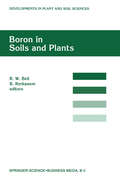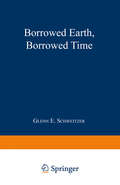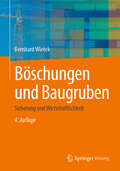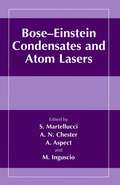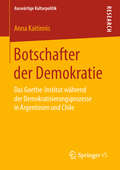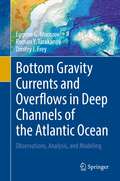- Table View
- List View
Boron in Soils and Plants: Proceedings of the International Symposium on Boron in Soils and Plants held at Chiang Mai, Thailand, 7–11 September, 1997 (Developments in Plant and Soil Sciences #76)
by R. W. Bell Benjavan RerkasemThe economic significance of boron (B) in agriculture, horticulture, and forestry has been beyond dispute for several decades. Even in the last two decades, the areas where B deficiency limits plant production has grown with increased reports from China, south Asia and southeast Asia. The present volume is reflective of the growing awareness of the significance of low soil B with reports from Australia, Bangladesh, Brazil, north, central and southern China, India, Nepal, and the North West Frontier Province of Pakistan contained herein. Boron deficiency also continues to be a problem for crop yield and quality in areas where B deficiency has been known for some time, for example in Germany and the USA. The problem of low soil B is not limited to effects on field crop yield, with papers reporting on depressed wood yield and quality in timber trees (Lambert et al. ), and depressed fruit quality (Dong et al. ; Smith et al. : Zude et al. ) also appearing in the present volume. Globally, Shorrocks (1997)1 estimates that ?? tonnes of B fertiliser is applied annually in agriculture. The economic benefits from the use of B fertiliser have not been quantified but are clearly enormous. Paradoxically, the clear economic imperatives for using B fertiliser on low B soils are not matched by a similar clarity of understanding of the role and functions of B in plants.
Boron Isotopes: The Fifth Element (Advances in Isotope Geochemistry)
by Horst Marschall Gavin FosterThis new volume on boron isotope geochemistry offers review chapters summarizing the cosmochemistry, high-temperature and low-temperature geochemistry, and marine chemistry of boron. It also covers theoretical aspects of B isotope fractionation, experiments and atomic modeling, as well as all aspects of boron isotope analyses in geologic materials using the full range of solutions and in-situ methods. The book provides guidance for researchers on the analytical and theoretical aspects, as well as introducing the various scientific applications and research fields in which boron isotopes currently play a major role. The last compendium to summarize the geochemistry of boron and address its isotope geochemistry was published over 20 years ago (Grew &Anovitz, 1996, MSA Review, Vol.33), and there have since been significant advances in analytical techniques, applications and scientific insights into the isotope geochemistry of boron. This volume in the “Advances in Isotope Geochemistry” series provides a valuable source for students and professionals alike, both as an introduction to a new field and as a reference in ongoing research.Chapters 5 and 8 of this book are available open access under a CC BY 4.0 license at link.springer.com
Boron Proxies in Paleoceanography and Paleoclimatology (Analytical Methods in Earth and Environmental Science)
by Bärbel Hönisch Stephen M. Eggins Laura L. Haynes Katherine A. Allen Katherine D. Holland Katja LorbacherAnthropogenic carbon dioxide emissions do not only warm our planet but also acidify our oceans. It is currently unclear to which degree Earth’s climate and marine life will be impacted by these changes but information from Earth history, particularly the geochemical signals of past environmental changes stored in the fossil remains of marine organisms, can help us predict possible future changes. This book aims to be a primer for scientists who seek to apply boron proxies in marine carbonates to estimate past seawater carbonate chemistry and atmospheric pCO2. Boron proxies (δ11B and B/Ca) were introduced nearly three decades ago, with subsequent strides being made in understanding their mechanistic functioning. This text reviews current knowledge about the aqueous systematics, the inorganic and biological controls on boron isotope fractionation and incorporation into marine carbonates, as well as the analytical techniques for measurement of boron proxies. Laboratory and field calibrations of the boron proxies are summarized, and similarities between modern calibrations are explored to suggest estimates for proxy sensitivities in marine calcifiers that are now extinct. Example applications illustrate the potential for reconstructing paleo-atmospheric pCO2 from boron isotopes. Also explored are the sensitivity of paleo-ocean acidity and pCO2 reconstructions to boron isotope proxy systematics that are currently less well understood, including the elemental and boron isotopic composition of seawater through time, seawater alkalinity, temperature and salinity, and their collective impact on the uncertainty of paleo-reconstructions. The B/Ca proxy is based on the same mechanistic principles as the boron isotope proxy, but empirical calibrations suggest seawater pH is not the only controlling factor. B/Ca therefore has the potential to provide a second carbonate parameter that could be paired with δ11B to fully constrain the ocean carbonate system, but the associated uncertainties are large. This text reviews and examines what is currently known about the B/Ca proxy systematics. As more scientists embark on characterizing past ocean acidity and atmospheric pCO2, Boron in Paleoceanography and Paleoclimatology provides a resource to introduce geoscientists to the opportunities and complications of boron proxies, including potential avenues to further refine them.
Boron Proxies in Paleoceanography and Paleoclimatology (Analytical Methods in Earth and Environmental Science)
by Bärbel Hönisch Stephen M. Eggins Laura L. Haynes Katherine A. Allen Katherine D. Holland Katja LorbacherAnthropogenic carbon dioxide emissions do not only warm our planet but also acidify our oceans. It is currently unclear to which degree Earth’s climate and marine life will be impacted by these changes but information from Earth history, particularly the geochemical signals of past environmental changes stored in the fossil remains of marine organisms, can help us predict possible future changes. This book aims to be a primer for scientists who seek to apply boron proxies in marine carbonates to estimate past seawater carbonate chemistry and atmospheric pCO2. Boron proxies (δ11B and B/Ca) were introduced nearly three decades ago, with subsequent strides being made in understanding their mechanistic functioning. This text reviews current knowledge about the aqueous systematics, the inorganic and biological controls on boron isotope fractionation and incorporation into marine carbonates, as well as the analytical techniques for measurement of boron proxies. Laboratory and field calibrations of the boron proxies are summarized, and similarities between modern calibrations are explored to suggest estimates for proxy sensitivities in marine calcifiers that are now extinct. Example applications illustrate the potential for reconstructing paleo-atmospheric pCO2 from boron isotopes. Also explored are the sensitivity of paleo-ocean acidity and pCO2 reconstructions to boron isotope proxy systematics that are currently less well understood, including the elemental and boron isotopic composition of seawater through time, seawater alkalinity, temperature and salinity, and their collective impact on the uncertainty of paleo-reconstructions. The B/Ca proxy is based on the same mechanistic principles as the boron isotope proxy, but empirical calibrations suggest seawater pH is not the only controlling factor. B/Ca therefore has the potential to provide a second carbonate parameter that could be paired with δ11B to fully constrain the ocean carbonate system, but the associated uncertainties are large. This text reviews and examines what is currently known about the B/Ca proxy systematics. As more scientists embark on characterizing past ocean acidity and atmospheric pCO2, Boron in Paleoceanography and Paleoclimatology provides a resource to introduce geoscientists to the opportunities and complications of boron proxies, including potential avenues to further refine them.
Böschungen und Baugruben: Sicherung und Wirtschaftlichkeit
by Bernhard WietekBöschungen als geneigte Erdoberflächen kommen überall vor. Sie werden bearbeitet und so der Zustand verändert. Damit müssen auch die Auswirkungen dieser Veränderungen betrachten und sich eine Gewissheit über die Sicherheit der Böschungen verschaffen werden. Erst mit dieser Kenntnis sollten Veränderungen durchgeführt werden um so auch deren Auswirkung die Umgebung abschätzen zu können. Baugruben werden immer tiefer und näher an Nachbarbauten gelegt. Es werden Verfahren angewendet, die den Sicherheitserfordernissen entsprechen. Die wirtschaftlichen Anforderungen lassen oft riskante Verfahren in den Blickwinkel kommen. Es sollte jedoch neben der Kosten besonders die Sicherheit für alle Bauwerke im Vordergrund stehen.
Böschungen und Baugruben: Sicherung und Wirtschaftlichkeit
by Bernhard WietekBöschungen als geneigte Erdoberflächen kommen überall vor. Sie werden bearbeitet und so der Zustand verändert. Damit müssen auch die Auswirkungen dieser Veränderungen betrachten und sich eine Gewissheit über die Sicherheit der Böschungen verschaffen werden. Erst mit dieser Kenntnis sollten Veränderungen durchgeführt werden um so auch deren Auswirkung die Umgebung abschätzen zu können. Baugruben werden immer tiefer und näher an Nachbarbauten gelegt. Es werden Verfahren angewendet, die den Sicherheitserfordernissen entsprechen. Die wirtschaftlichen Anforderungen lassen oft riskante Verfahren in den Blickwinkel kommen. Es sollte jedoch neben der Kosten besonders die Sicherheit für alle Bauwerke im Vordergrund stehen.
Böschungen und Baugruben: Sicherung und Wirtschaftlichkeit
by Bernhard WietekBöschungen als geneigte Erdoberflächen kommen überall vor. Sie werden bearbeitet und so der Zustand verändert. Damit müssen auch die Auswirkungen dieser Veränderungen betrachten und sich eine Gewissheit über die Sicherheit der Böschungen verschaffen werden. Erst mit dieser Kenntnis sollten Veränderungen durchgeführt werden um so auch deren Auswirkung die Umgebung abschätzen zu können. Baugruben werden immer tiefer und näher an Nachbarbauten gelegt. Es werden Verfahren angewendet, die den Sicherheitserfordernissen entsprechen. Die wirtschaftlichen Anforderungen lassen oft riskante Verfahren in den Blickwinkel kommen. Es sollte jedoch neben der Kosten besonders die Sicherheit für alle Bauwerke im Vordergrund stehen.
Böschungen und Baugruben: Sicherung und Wirtschaftlichkeit
by Bernhard WietekDieses neu aufgelegte Buch geht mit technischem Wissen an die Problematik der Böschungen und Baugruben heran und gibt Hilfestellung, die Gefahren besser zu beherrschen und somit Schaden von der Bevölkerung abzuwenden. Böschungen als geneigte Erdoberflächen kommen überall vor. Sie werden vom Menschen mehr oder weniger bearbeitet und so der natürliche Zustand verändert. Damit sollte man auch die Auswirkungen dieser Veränderungen betrachten und sich eine Gewissheit über die Sicherheit der Böschungen verschaffen. Erst mit dieser Kenntnis sollten Veränderungen durchgeführt werden, um so auch deren Auswirkung auf den Menschen und die Umgebung abschätzen zu können. Baugruben werden immer tiefer und näher an Nachbarbauten gelegt und sind daher ingenieurmäßig zu bearbeiten. Es werden nicht immer Verfahren angewendet, die den Sicherheitserfordernissen entsprechen. Die wirtschaftlichen Anforderungen lassen oft riskante Verfahren in den Blickwinkel kommen. Es sollte jedoch neben den Kosten besonders die Sicherheit für alle Bauwerke im Vordergrund stehen.
Bose Algebras: The Complex and Real Wave Representations (Lecture Notes in Mathematics #1472)
by Torben T. NielsenThe mathematics of Bose-Fock spaces is built on the notion of a commutative algebra and this algebraic structure makes the theory appealing both to mathematicians with no background in physics and to theorectical and mathematical physicists who will at once recognize that the familiar set-up does not obscure the direct relevance to theoretical physics. The well-known complex and real wave representations appear here as natural consequences of the basic mathematical structure - a mathematician familiar with category theory will regard these representations as functors. Operators generated by creations and annihilations in a given Bose algebra are shown to give rise to a new Bose algebra of operators yielding the Weyl calculus of pseudo-differential operators. The book will be useful to mathematicians interested in analysis in infinitely many dimensions or in the mathematics of quantum fields and to theoretical physicists who can profit from the use of an effective and rigrous Bose formalism.
Bose-Einstein Condensates and Atom Lasers
by S. Martellucci Alain Aspect Arthur N. Chester Massimo InguscioProceedings of the International School of Quantum Electronics 27th course on Bose Einstein Condensates and Atom Lasers, October 19-24, 1999, Erice, Italy. Since the experimental demonstration of Bose Einstein Condensation in dilute atomic gases there has been an explosion of interest in the properties of this novel macroscopic quantum system. The book covers the methods used to produce these new samples of coherent atoms, their manipulation and the study of their properties. Emphasis is given to the anticipated development of new types of sources, which more and more resemble traditional types of lasers. Because of recent new applications and increasing demand for lasers, sensors and associated instrumentation, the chapters also cover current developments in the basic techniques, materials and applications in the field of the generation of coherent atoms.
Bose-Einstein-Kondensate in höheren Bändern des hexagonalen Gitters: Von rf-Techniken einer Gitterstabilisierung hin zum dynamischen Quantenphasenübergang
by Julius SeegerDieses Buch beschreibt die erstmalige, erfolgreiche Realisierung unkonventioneller Superfluide in höheren Bändern des hexagonalen optischen Gitters. Der Populationstransfer und der anschließende dynamische Quantenphasenübergang werden ausführlich diskutiert. Schließlich werden die Metastabilität und Zerfallskanäle des ultrakalten Systems experimentell nachgewiesen. Durch die Reduktion von Phasenrauschen des optischen Gitters konnte die Lebensdauer des ultrakalten Ensembles um etwa eine Größenordnung erhöht werden. Weiterhin werden die optische Phasenregelschleife und Intensitätsstabilisierung des Gitters vorgestellt. Mit den in diesem Buch beschriebenen Ergebnissen und technologischen Entwicklungen werden die derzeit bestehenden Grenzen der Quantensimulation mittels ultrakalter Gase in optischen Gittern aufgehoben und der Weg für zahlreiche nachfolgende Untersuchungen bereitet.
Bosnia and the Destruction of Cultural Heritage (Heritage, Culture and Identity)
by Valery Perry Helen Walasek contributions by Carlton Amra Hadžimuhamedović Tina WikThe massive intentional destruction of cultural heritage during the 1992-1995 Bosnian War targeting a historically diverse identity provoked global condemnation and became a seminal marker in the discourse on cultural heritage. It prompted an urgent reassessment of how cultural property could be protected in times of conflict and led to a more definitive recognition in international humanitarian law that destruction of a people's cultural heritage is an aspect of genocide. Yet surprisingly little has been published on the subject. This wide-ranging book provides the first comprehensive overview and critical analysis of the destruction of Bosnia-Herzegovina's cultural heritage and its far-reaching impact. Scrutinizing the responses of the international community during the war (including bodies like UNESCO and the Council of Europe), the volume also analyses how, after the conflict ended, external agendas impinged on heritage reconstruction to the detriment of the broader peace process and refugee return. It assesses implementation of Annex 8 of the Dayton Peace Agreement, a unique attempt to address the devastation to Bosnia's cultural heritage, and examines the treatment of war crimes involving cultural property at the International Criminal Tribunal for the former Yugoslavia (ICTY). With numerous case studies and plentiful illustrations, this important volume considers questions which have moved to the foreground with the inclusion of cultural heritage preservation in discussions of the right to culture in human rights discourse and as a vital element of post-conflict and development aid.
Bosnia and the Destruction of Cultural Heritage (Heritage, Culture and Identity)
by Valery Perry Helen Walasek contributions by Carlton Amra Hadžimuhamedović Tina WikThe massive intentional destruction of cultural heritage during the 1992-1995 Bosnian War targeting a historically diverse identity provoked global condemnation and became a seminal marker in the discourse on cultural heritage. It prompted an urgent reassessment of how cultural property could be protected in times of conflict and led to a more definitive recognition in international humanitarian law that destruction of a people's cultural heritage is an aspect of genocide. Yet surprisingly little has been published on the subject. This wide-ranging book provides the first comprehensive overview and critical analysis of the destruction of Bosnia-Herzegovina's cultural heritage and its far-reaching impact. Scrutinizing the responses of the international community during the war (including bodies like UNESCO and the Council of Europe), the volume also analyses how, after the conflict ended, external agendas impinged on heritage reconstruction to the detriment of the broader peace process and refugee return. It assesses implementation of Annex 8 of the Dayton Peace Agreement, a unique attempt to address the devastation to Bosnia's cultural heritage, and examines the treatment of war crimes involving cultural property at the International Criminal Tribunal for the former Yugoslavia (ICTY). With numerous case studies and plentiful illustrations, this important volume considers questions which have moved to the foreground with the inclusion of cultural heritage preservation in discussions of the right to culture in human rights discourse and as a vital element of post-conflict and development aid.
Bosonization of Interacting Fermions in Arbitrary Dimensions (Lecture Notes in Physics Monographs #48)
by Peter KopietzThe author presents in detail a new non-perturbative approach to the fermionic many-body problem, improving the bosonization technique and generalizing it to dimensions d1 via functional integration and Hubbard--Stratonovich transformations. In Part I he clearly illustrates the approximations and limitations inherent in higher-dimensional bosonization and derives the precise relation with diagrammatic perturbation theory. He shows how the non-linear terms in the energy dispersion can be systematically included into bosonization in arbitrary d, so that in d1 the curvature of the Fermi surface can be taken into account. Part II gives applications to problems of physical interest. The book addresses researchers and graduate students in theoretical condensed matter physics.
Botanisch-geologische Spaziergänge in der Umgegend von Berlin
by W. GothanDieser Buchtitel ist Teil des Digitalisierungsprojekts Springer Book Archives mit Publikationen, die seit den Anfängen des Verlags von 1842 erschienen sind. Der Verlag stellt mit diesem Archiv Quellen für die historische wie auch die disziplingeschichtliche Forschung zur Verfügung, die jeweils im historischen Kontext betrachtet werden müssen. Dieser Titel erschien in der Zeit vor 1945 und wird daher in seiner zeittypischen politisch-ideologischen Ausrichtung vom Verlag nicht beworben.
Botany For Dummies
by Rene Fester KratzHarvest basic botany knowledge from this abundant book Botany For Dummies gives you a thorough overview of the fundamentals of botany, but in simple terms that anyone can understand. Great for supplementing your botany coursework or brushing up before an exam, this book covers plant evolution, the structure and function of plant cells, and plant identification. Plus, you'll learn about how plants of different types are changing and adapting in response to changing climates. This new edition goes into more detail on fungi—not technically plants, but no one is holding that against them. Regardless of what brought you to the wonderful world of botany, this book will show you around. Get an easy-to-understand introduction to the key concepts in botany Read about recent discoveries and theories in the world of plant science Understand different families of plants and where they grow Improve your grade and pass your exam in your introductory botany course Get a copy of Botany For Dummies and watch your botany knowledge bloom.
Both Sides of the Border: Transboundary Environmental Management Issues Facing Mexico and the United States (The Economics of Non-Market Goods and Resources #2)
by Linda Fernandez Richard T. CarsonThe Mexican -- United States border represents much more than the meeting place of two nations. Our border communities are often a line of first defense -- absorbing the complex economic, environmental and social impacts of globalization that ripple through the region. In many ways, our success or failure in finding solutions for the environmental, social and economic issues that plague the region may well define our ability to meet similar challenges thousands of miles from the border zone. Border residents face the environmental security concerns posed by water scarcity and transboundary air pollution; the planning and infrastructure needs of an exploding population; the debilitating effects of inadequate sanitary and health facilities; and the crippling cycle of widespread poverty. Yet, with its manifold problems, the border area remains an area of great dynamism and hope -- a multicultural laboratory of experimentation and grass-roots problem-solving. Indeed, as North America moves towards a more integrated economy, citizen action at the local level is pushing governments to adapt to the driving forces in the border area by creating new institutional arrangements and improving old ones. If there is one defining feature of this ground-up push for more responsive transboundary policies and institutions, it is a departure from the closed, formalistic models of the past to a more open, transparent and participatory model of international interaction.
Bothy: In Search of Simple Shelter
by null Kat HillLONGLISTED FOR THE WAINWRIGHT PRIZE ‘The bothy embrace is addictive’ ADAM NICOLSON 'Will have you reaching for your boots’ CAL FLYN The door to the bothy is always unlocked, you just need to step inside. You will find them in the mountains. You will find them in the wilderness. A bothy is a remote hut you can’t reserve, with no electricity, mod-cons or running water. And it’s here you’ll find Kat Hill – kettle on, feet up and pen out. Leading us on a gorgeous and erudite journey around the UK, Kat reveals the history of these wild mountain shelters and the people who visit them. With a historian’s insight and a rambler’s imagination, she lends fresh consideration to the concepts of nature, wilderness and escape. All the while, Kat weaves together her story of heartbreak and new purpose with those of her fellow wanderers, past and present. Writing with warmth, wit and infectious wanderlust, Kat moves from a hut in an active military training area in the far-north of Scotland to a fairy-tale cottage in Wales. Along her travels, she explores the conflict between our desire to preserve isolated beauty and the urge to share it with others – embodied by the humble bothy. Bothy is a stirring, beautiful book for anyone who longs to run away to the wilds.
Botschafter der Demokratie: Das Goethe-Institut während der Demokratisierungsprozesse in Argentinien und Chile (Auswärtige Kulturpolitik)
by Anna KaitinnisAnna Kaitinnis untersucht unter Heranziehung transformationstheoretischer Ansätze Zusammenhänge zwischen auswärtiger Kulturarbeit und externer Demokratieförderung am Beispiel des Goethe-Instituts in Argentinien (1982-1989) und Chile (1988-1994). Von ihren Erkenntnissen leitet sie konkrete Handlungsempfehlungen für die auswärtige Kulturarbeit des Goethe-Instituts in Ländern ab, die sich in einem Demokratisierungsprozess befinden. Diese Empfehlungen sind ebenfalls für andere Akteure auswärtiger Kulturarbeit wie auch für zukünftige Konzeptionen einer Auswärtigen Kulturpolitik gewinnbringend.
Bottom Gravity Currents and Overflows in Deep Channels of the Atlantic Ocean: Observations, Analysis, and Modeling
by Eugene G. Morozov Roman Y. Tarakanov Dmitry I. FreyThis book is dedicated to the analysis of bottom waters flows through underwater channels of the Atlantic Ocean. The study is based on recent observations of the authors, analysis of historical data, numerical modeling, and literature review. For example, studying both the measurements from the World Ocean Circulation experiment in the 1990s and recent measurements reveals the decadal variations of water properties in the ocean.Seawater is cooled at high latitudes, descends to the ocean bottom, and slowly flows to the tropical latitudes and further. This current is slow in the deep basins, but intensifies in the abyssal channels connecting the basins. The current overflows submarine topographic structures and sometimes forms deep cataracts when water descends over slopes by several hundred meters. The flow of Antarctic Bottom Water (AABW) is studied on the basis of CTD sections combined with Lowered Acoustic Doppler Profiling (LADCP) carried out annually, and long-term moored measurements of currents. This book is a collection of oceanographic data, interpretation, and analysis, which can be used by field oceanographers, specialists in numerical modeling, and students who specialize in oceanography.
Bottom-Interacting Ocean Acoustics (Nato Conference Series #5)
by William A. Kupermanvi These categories seem to represent the basic breakdown by field of present-day research in this area. Though each paper has been classified into one of these categories (for conference organization purpose), many papers overlapped two or three areas. It is also interesting to note that not only are scientific results being communicated, but the latest techniques and the state-of-the-art tools of the trade (existing and in development) are also being presented. The forty-six papers presented at this conference represent the work of seventy scientists working at universities, government laboratories, and industrial laboratories in seven different countries . We would like to thank the contributors for their efforts and especially for their promptness in providing the editors with their final manuscripts. William A. Kuperman Finn B. Jensen La Spezia, Italy July 1980 CONTENTS GEOACOUSTIC PROPERTIES OF MARINE SEDIMENTS Attenuation of Sound in Marine Sediments . • 1 J. M. Hovem Directivity and Radiation Impedance of a Transducer 15 Embedded in a Lossy Medium . •• •••••• G. H. Ziehm Elastic Properties Related to Depth of Burial, Strontium Content and Age, and Diagenetic Stage in Pelagic Carbonate Sediments . . • • . • • • . 41 M. H. Manghnani, S. O. Schianger, and P. D. Milholland Application of Geophysical Methods 'and Equipment to Explore the Sea Bottom . •• •••. • 53 H. F. Weichart The Acoustic Response of Some Gas-Charged Sediments in the Northern Adriatic Sea • • • • . • • • • 73 A.
The Bottom of the Main Sequence — And Beyond: Proceedings of the ESO Workshop Held in Garching, Germany, 10–12 August 1994 (ESO Astrophysics Symposia)
by Christopher G. TinneyThe proceedings of this workshop should probably be prefaced with a few words on some of the more confusing jargon. The phrases "Very Low-Mass star" , "VLM star", or simply "VLM" are now used fairly uniformly by as tronomers studying the stars at the bottom of the hydrogen-burning stellar main sequence - unfortunately, however, there is no clear definition as to what constitutes a VLM star. The reader should be warned that VLM stars are variously considered to be stars with; masses less than 0.3M ; masses 0 less than 0.1M ; spectra later than about M6-7; luminosities fainter than 0 Mv = 15; or luminosities fainter than Mbol = 12. The important features of a VLM star, however, would seem to be (1) that it is about as faint as a star can be, and (2) that it still remains a star (ie. it still burns hydrogen) . All of the above criteria, therefore, would seem to qualify an object as a VLM star, and requiring a more stringent definition is probably quibbling.
Bouguer Gravity Regional and Residual Separation: Application to Geology and Environment
by K. Mallick A. Vasanthi K.K. SharmaThe process of regional-residual separation in potential field is age-old. Broadly, there are two techniques for regional-residual resolution, viz., graphical and analytical. Both the techniques have their own respective shortcomings. In this book, the authors have described the technique based on finite element method in which only eight (or twelve) nodal observed gravity values are used for the regional computation, thereby eliminating the possible contamination of anomalous fields and also the technique does not assume an explicit model and physical properties like density of rocks etc. in the regional computation. The book discusses the advantages of this technique viz., it is not site-specific; the computation is independent of any prior assumptions as to the form and depth of shallow or deeper structures; it can handle data distributed at random or on a regular grid on the map space; and the neighbouring surveys join smoothly. The book focuses on application of this new technique which has been demonstrated in different fields, such as hydrocarbon, minerals and groundwater, structural studies, earthquake and engineering studies and impact structures.
Boundaries of a Complex World (Springer Series in Synergetics)
by Andrei LuduThe central theme of this book is the extent to which the structure of the free dynamical boundaries of a system controls the evolution of the system as a whole. Applying three orthogonal types of thinking - mathematical, constructivist and morphological, it illustrates these concepts using applications to selected problems from the social and life sciences, as well as economics. In a broader context, it introduces and reviews some modern mathematical approaches to the science of complex systems. Standard modeling approaches (based on non-linear differential equations, dynamic systems, graph theory, cellular automata, stochastic processes, or information theory) are suitable for studying local problems. However they cannot simultaneously take into account all the different facets and phenomena of a complex system, and new approaches are required to solve the challenging problem of correlations between phenomena at different levels and hierarchies, their self-organization and memory-evolutive aspects, the growth of additional structures and are ultimately required to explain why and how such complex systems can display both robustness and flexibility. This graduate-level text also addresses a broader interdisciplinary audience, keeping the mathematical level essentially uniform throughout the book, and involving only basic elements from calculus, algebra, geometry and systems theory.
